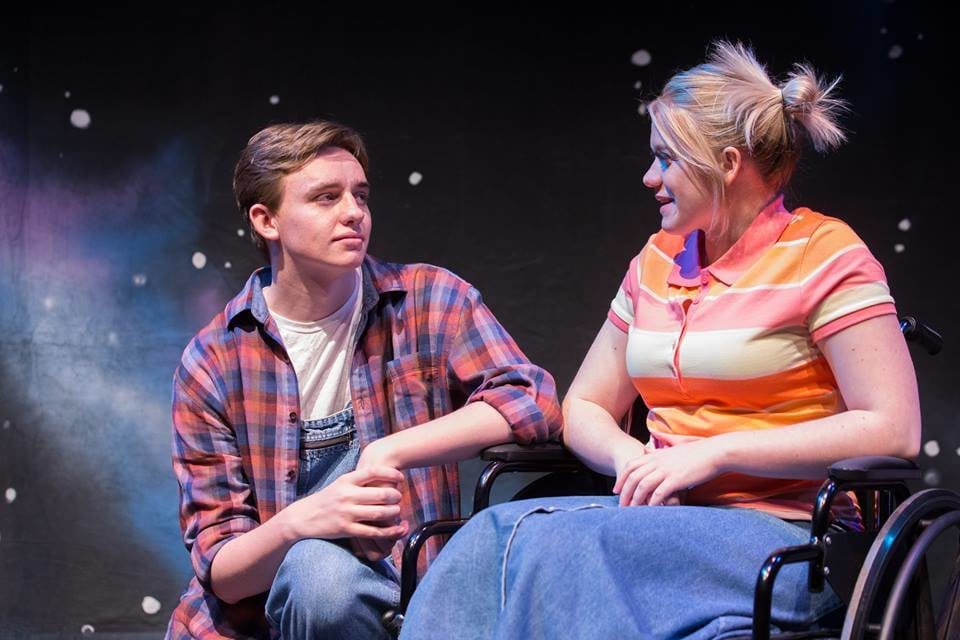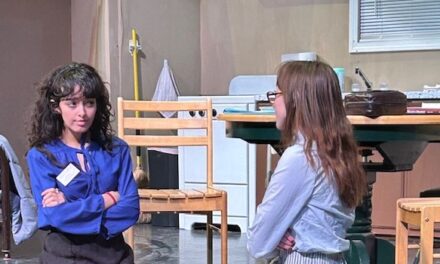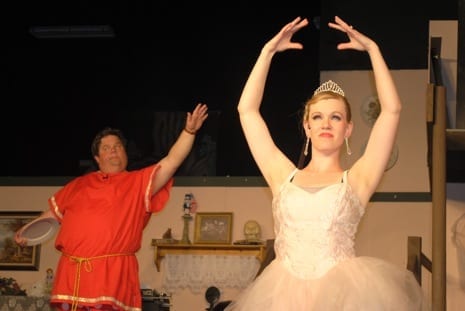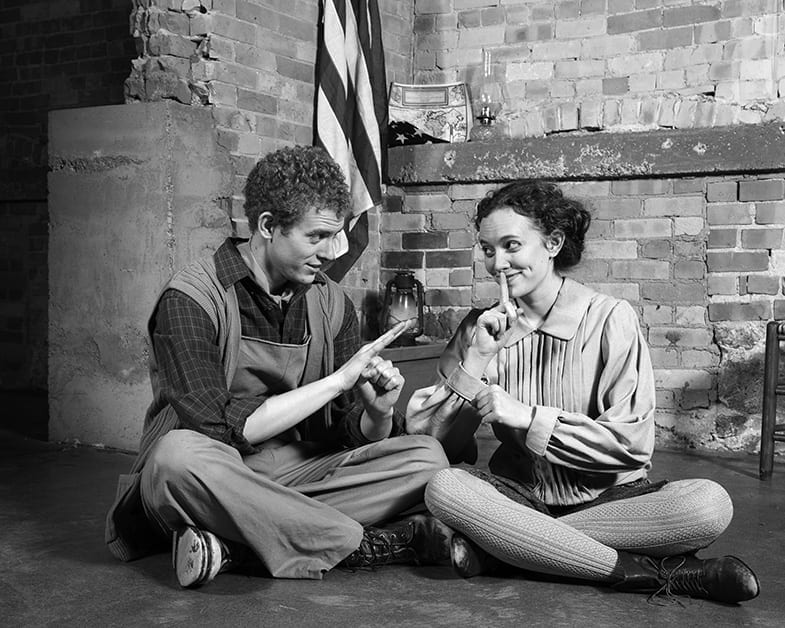OREM — In its opening song, Saturday’s Warrior tells the audience exactly what the play is about. “We must learn why we’re here and who we are.” Although Saturday’s Warrior is probably the best known Mormon theatre piece, this journey of self-discovery has universal appeal. Although major portions of the show are loosely based on the LDS doctrine of life before mortality, the current production at the SCERA does not require any special knowledge of Mormonism or Mormon culture to enjoy.

Show closes May 7, 2016.
Saturday’s Warrior begins in heaven in the pre-mortal life, where several individuals are waiting at a staging area for their turn to come down to earth. Knowing that earth life is riskier and more difficult than staying in heaven, there’s a lot of nervous excitement as each person awaits their birth. Among these individuals are Jimmy—who is to be the oldest of a large Mormon family—with all his siblings, two individuals who plan on serving LDS missions together during their mortal life, and a couple in love who hope to find one another on earth. From an LDS perspective, the conflicts of Saturday’s Warrior are full of dramatic tension because they are the same conflicts that every person on earth faces in real life: whether, without the help of their memory of their life before birth, they will fulfill their goals that they made for mortality.
When it premiered in 1974, Saturday’s Warrior was not just a hit, but it was a Mormon cultural phenomenon. The show still continues to make its impact on LDS culture today, as demonstrated by the new film version that premiered a few weeks ago. It’s easy to see why the show has been a favorite. The play is populated by the rank-and-file of 20th century American Mormonism, and it’s likely that many people over the years have seen themselves in one or more of the people on stage.

Tanner Perkins as Jimmy Flinders and McKenna Hixson as Pam Flinders.
Central to the story is Jimmy Flinders, played by Tanner Perkins. As a young man, Jimmy feels alienated by his distinctively uncool, straightlaced Mormon family, and Perkins serves the role well by showing the embarrassment that almost every teenager has felt because of their parents. With his performance, Perkins makes Jimmy the most real character, especially in his interactions with Pam (played by McKenna Hixson) who is Jimmy’s twin sister. Their sibling interactions in “Line Upon Line” made his character have a soft side, rather than just being a Mormon rebel without a cause. On the other hand, Perkins gave Jimmy just the edge needed to make his alienation real, such as in the arguments and fights with his other siblings, or his frustration with his parents for ignoring him because they have too many other children.

Left to right: Chris Rollins as Elder Wally Kestler, Alex Pierson as Tod, and Eric Taylor as Elder Harold Greene.
Kelsea Kocherhans played Julie Flinders, Jimmy and Pam’s younger sister. Julie has recently sent a missionary away, and Kocherhans gave Julie a naive devotion to her man that captured the character’s youth and innocence well. That man is Elder Wally Kestler, a missionary with boundless enthusiasm, played by Chris Rollins. In all of his scenes, Rollins showed that Kestler was single-mindedly dedicated to his calling, especially in the way he contacted strangers in public and tried to get them to listen to his message. Kestler’s enthusiasm when he found someone to listen to him (Tod, played by Alex Pierson) would be familiar to anyone who has served an LDS mission.
Unfortunately, the ensemble members who played Jimmy’s friends were weaker in their performances. If they’re the wrong crowd for Jimmy, it was often tough to see why. Some of them were too clean cut, and I couldn’t find why Jimmy’s parents would worry about them hanging around him. Granted, this is a family show, so it’s not like the actors could shoot up heroin or talk about a wild night of passion. But the group didn’t seem all that dangerous to Jimmy’s soul. The general ensemble was weak in the execution of Shawn M. Mortensen‘s choreography, even though the movement was very simple, even by the standards of community theatre. This made songs like “Voices” and “Summer of Fair Weather” less exciting than Lex de Azevedo’s music could have been. The ensemble seemed to be cast for their voices, and not their dancing ability.

Tanner Perkins as Jimmy Flinders.
Director Jeremy Showgren chose to set the play in the mid-1990’s, an era halfway between the show’s debut and the present day. The change in time period doesn’t work completely, such as when Jimmy’s friends (led by Mack, played by Jacom Clarkson) are worked up over Malthusian concerns like overpopulation and running out of oil in “Zero Population.” As a child of the nineties, I can attest that these issues were not the major concern in that era, like they were in the early 1970’s when Doug Stewart wrote the script. But after the first third of the play these concerns melted away, and I realized that treating the show like a period piece emphasizes the timeless nature of the core themes: finding one’s identity, hoping for the return of the prodigal son, and the importance of “pulling together” as a family to make it through hard troubled times. Fans of the show will also appreciate the nuggets of humor that Showgren slipped into the stage business, several of which made both my wife and me laugh out loud. Showgren also ensured that the scenes clipped along well and made the sometimes stilted dialogue seem natural.
Integral to the 1990’s setting were Kelsey Seaver’s costumes, which will feel eerily familiar to anyone who was around at the time. Every actor was clad in fashionable items of the time, like Doc Martens, plaid shirts, a 1990’s era Karl Malone jersey, a D.A.R.E. shirt, and more. On the other hand, the costumes in heaven were less satisfying because it looked like a Hollywood caricature of what devout Christians wear to church on Sundays. To be fair to Seaver, though, I have no idea what people would wear in heaven before being born, and all-white would definitely not be the right choice for this play. M’Liss Tolman‘s set added to the historical feel of the show. The Flinders living room, with its earth toned furniture and pattern drapes transported me to the living room of my childhood home. However, the principal set pieces that served to create many different settings had signage for airport gates painted on them, which was distracting for the scenes not set in the airport. Finally, Elizabeth Griffiths’s lighting design highlighted the mood of critical scenes, such as in heaven or during the songs “Voices” and “Line Upon Line.”
Given its age and popularity, it is no surprise that Saturday’s Warrior has a reputation. And that reputation is for cheese. Though I had never seen the show before, I knew its reputation through brief glimpses of the 1989 video version aired on TV, the soundtrack my parents owned when I was young, and comments from other theatre people about how corny the play is. Yes, it has “Zero Population” and the “Daddy’s Nose.” Yes, it wears its heart on its sleeve. Yes, the play’s message may seem unsophisticated to the modern world. But Saturday’s Warrior is a great temporary antidote to the widespread cynicism, political polarization, and hostility towards tradition that is rampant in the world today. Although not a flawlessly polished production, the SCERA has a genuinely enjoyable version of this Utah classic.





